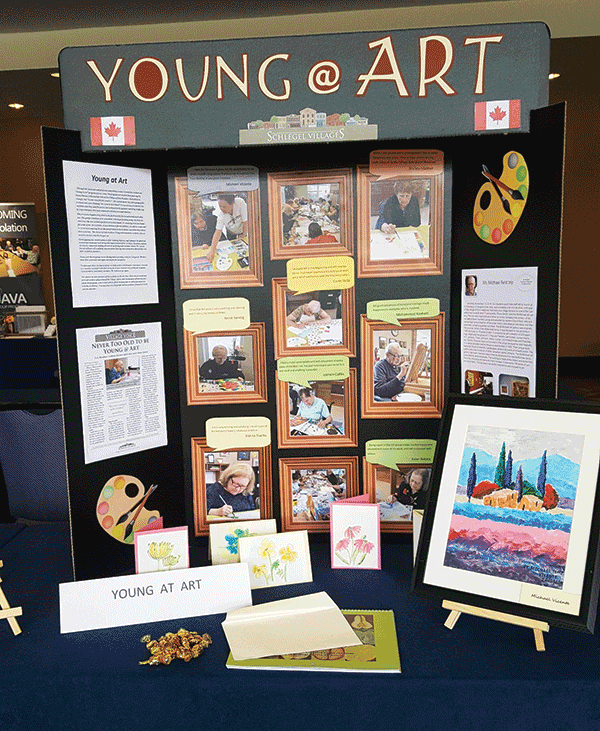

Networking and storytelling are two of the best ways to share with fellow pioneers.
Poster Sessions and Story Boards will be on display this year outside the general session rooms and on Tuesday from 12 pm – 1 pm, Pioneer Network Board Member and Education Committee Chair, Marguerite McLaughlin will be leading a 1-hour guided tour visiting with each of the poster session and storyboard guides. (and we have submitted for Continuing Education!).
Whether you join the Gallery Walk, or visit on your own, you will have an opportunity to read stories about the work being done by fellow pioneers and engage individuals from those settings in a conversation that might spark an idea for your community. What a great way to promote growth and development for all.
2019 Poster Sessions and Story Boards
Bringing The Heart and Spirit to the Household Model
Jacqueline Hart, Park Springs
The program provides an introduction to unique program of the Butterfly model of care and its collaborative framework of support for its established households. Experience Park Springs’ unique model of care, including introduction to both the household and Butterfly programs and how they complement one another. We will demonstrate how empowering and educating care teams to utilize emotional intelligence through empathy training. Supporting adaptable, empowered care teams who provide excellence in person centered/directed care improves employee and resident retention by allowing autonomy, meaning and joy as a daily experience lived.
Preventing Harm in Nursing Homes: New Change Package
Kelly O’Neill, Marilyn Reierson & Angel Davis
With a goal of improving quality of care and life experienced by nursing home residents and to support nursing homes in reducing the prevalence of harm, the Centers for Medicare & Medicaid Services supported development of a Change Package focused on all cause harm prevention. Join us during the poster session to learn about this quality improvement initiative and to find out how to access this resource which includes strategies and actions to begin testing for purposes of improving residents’ quality of life through safer care, while honoring each resident’s rights and preferences.
Living as a Resident
Leslie Pedke
‘Through the Looking Glass’ is a program developed at Aviston Countryside Manor to teach empathy to our caregivers. Staff members moved into the nursing home, lived the role of a real diagnosis and accepted daily ‘challenges’ our residents experience every day.
From learning the importance of communicating more with residents to encouraging meaningful activities, the resulting insights of these caregivers sensitized other staff members – new and veteran – to practical and effective ways that they were able to immediately improve daily care to residents.
This program became the culture of Aviston Countryside Manor and grew into an Elder Shadowing program that required all newly hired staff to live with a resident for 24 hours before they are able to begin their new job.
Building Resources for Delivering Person-Centered Care in Georgia Nursing Home Project
Kim McRae & Jennifer Craft Morgan
The Culture Change Network of Georgia and Georgia State University’s Gerontology Institute recently received a $1.6 million joint grant from the Centers for Medicare & Medicaid Services (CMS) and the Georgia State Survey Agency to support a three-year training and development project.
This project builds on the momentum of the Culture Change Network of Georgia, whose efforts have been ongoing to support Culture Change and Person-Centered Care across long-term care services and support organizations. Come learn about this multiyear project to develop a sustainable program model aimed at improving the quality of life of Georgia nursing home residents, including those living with dementia, by providing important resources, staff development, and training to the state’s 374 nursing homes. The overall aim of this project is to create a sustainable model for improving the quality of life for nursing home residents in Georgia.
Behaviors as Communication: Learn How to Speak My Language
Kelly Klund, Empira
To have behavior is human. Often people with dementia or cognitive impairments express their needs through “behaviors” that we perceive as negative. This session will help learners understand the how to interpret and respond to “behaviors” as an individual’s way of communicating those needs.
Montessori Approach
Jennie Keleher
Montessori introduces practical approaches to identify resident strengths (e.g., reading assessments), ways to use remaining strengths to promote independence (e.g., external cues, categorical decision-making), and strategies for fostering community and meaningful activity (e.g., resident committees, how to offer more meaningful choices, etc.). Come learn about the implementation and outcomes of the Montessori approach as experienced across 8 Community Living Centers (CLC) in the VA system.
Heart to Serve
Annie Dunlap
Come and learn about the program that was the inspiration for the Community Commitment Awards, A Heart to Serve. This program offers residents of nursing homes the opportunity to volunteer on teams that give back to their communities. We are constantly looking to provide opportunities to our residents that bring them back to a high level of functioning. Being needed to complete a task when the task does not sound easy or fun brings out a sense of purpose and pride in an individual.
A Day and Night Difference: Creating a Culture of Restorative Sleep
Heather Johnson, RN and Resource Nurse with Empira
CMS and long-term care providers have never considered sleep as an integral part of the plan of care and services provided for the resident. Through root cause analysis, Empira identified sleep fragmentation as a primary cause of some of the most challenging issues facing aging services. By taking on a multi-pronged approach including clinical, operational and environmental interventions provided multiple opportunities for improvement beyond the Quality Indicators and Quality of Life Measures. We approached this program to improve not only the contractual performance measures, but also the top ten sleep disruptions which then became the cornerstones of this program.

